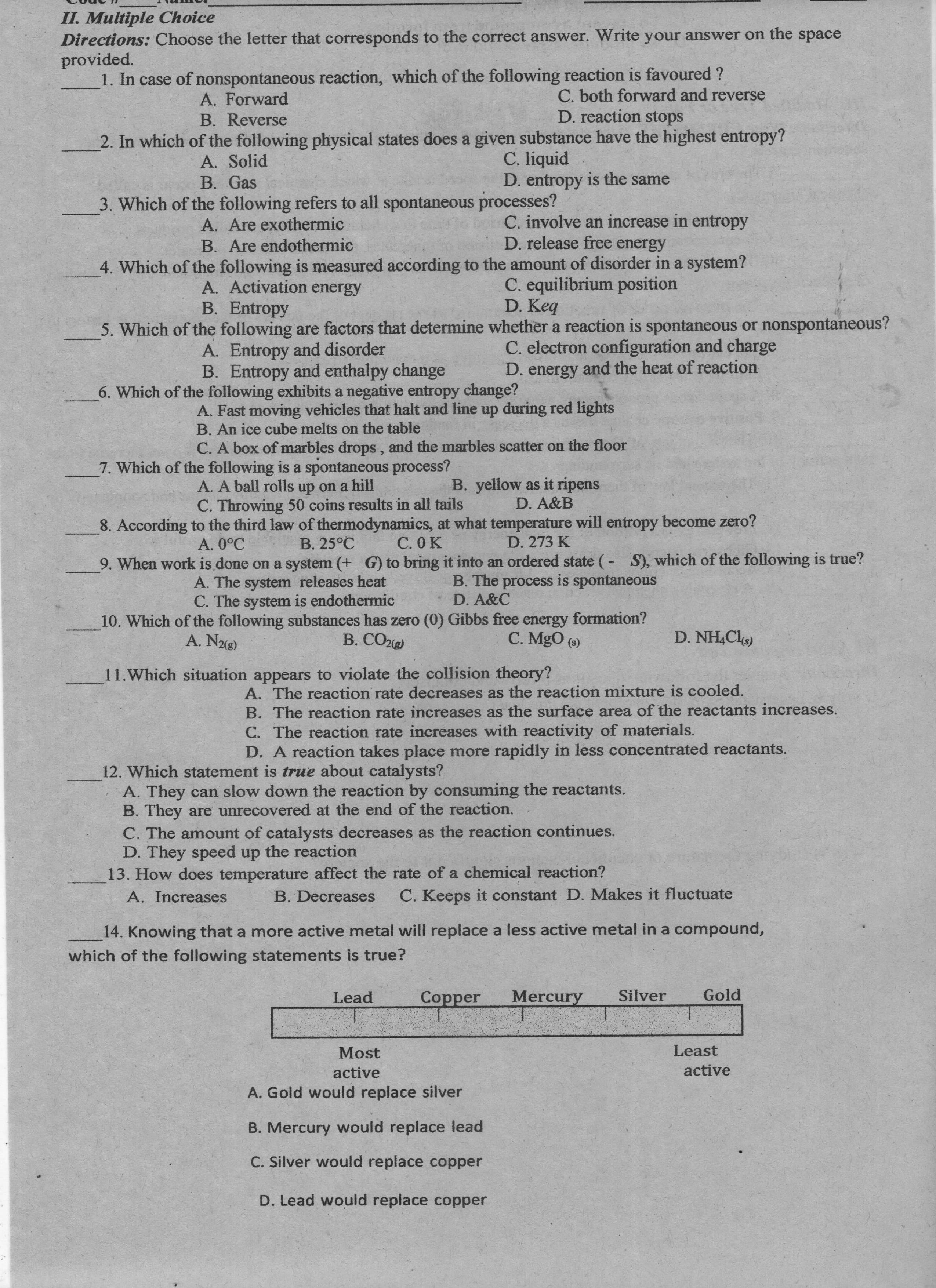General Chemistry - Standalone book (MindTap Course List)
11th Edition
ISBN:9781305580343
Author:Steven D. Gammon, Ebbing, Darrell Ebbing, Steven D., Darrell; Gammon, Darrell Ebbing; Steven D. Gammon, Darrell D.; Gammon, Ebbing; Steven D. Gammon; Darrell
Publisher:Steven D. Gammon, Ebbing, Darrell Ebbing, Steven D., Darrell; Gammon, Darrell Ebbing; Steven D. Gammon, Darrell D.; Gammon, Ebbing; Steven D. Gammon; Darrell
Chapter18: Thermodynamics And Equilibrium
Section: Chapter Questions
Problem 18.28QP
Related questions
Question
100%
MULTIPLE CHOICE ONLY NUMBER 11-14

Transcribed Image Text:II. Multiple Choice
Directions: Choose the letter that corresponds to the correct answer. Write your answer on the space
provided.
1. In case of nonspontaneous reaction, which of the following reaction is favoured ?
A. Forward
C. both forward and reverse
B. Reverse
D. reaction stops
2. In which of the following physical states does a given substance have the highest entropy?
C. liquid
D. entropy is the same
3. Which of the following refers to all spontaneous processes?
A. Solid
B. Gas
A. Are exothermic
B. Are endothermic
C. involve an increase in entropy
D. release free energy
C. equilibrium position
D. Keq
5. Which of the following are factors that determine whether a reaction is spontaneous or nonspontaneous?
4. Which of the following is measured according to the amount of disorder in a system?
A. Activation energy
B. Entropy
A. Entropy and disorder
B. Entropy and enthalpy change
C. electron configuration and charge
D. energy and the heat of reaction
6. Which of the following exhibits a negative entropy change?
A. Fast moving vehicles that halt and line up during red lights
B. An ice cube melts on the table
C. A box of marbles drops , and the marbles scatter on the floor
7. Which of the following is a spontaneous process?
A. A ball rolls up on a hill
B. yellow as it ripens
D. A&B
C. Throwing 50 coins results in all tails
8. According to the third law of thermodynamics, at what temperature will entropy become zero?
C. OK
A. 0°C
B. 25°C
D. 273 K
9. When work is done on a system (+ G) to bring it into an ordered state (- S), which of the following is true?
B. The
B. The process is spontaneous
is spontaneous
A. The system releases heat
C. The system is endothermic
D. A&C
10. Which of the following substances has zero (0) Gibbs free energy formation?
B. CO2)
A. N2(g)
C. MgO (9)
D. NH,Cl)
11.Which situation appears to violate the collision theory?
A. The reaction rate decreases as the reaction mixture is cooled.
B. The reaction rate increases as the surface area of the reactants increases.
C. The reaction rate increases with reactivity of materials.
D. A reaction takes place more rapidly in less concentrated reactants.
12. Which statement is true about catalysts?
A. They can slow down the reaction by consuming the reactants.
B. They are unrecovered at the end of the reaction.
C. The amount of catalysts decreases as the reaction continues.
D. They speed up the reaction
13. How does temperature affect the rate of a chemical reaction?
A. Increases
B. Decreases
C. Keeps it constant D. Makes it fluctuate
14. Knowing that a more active metal will replace a less active metal in a compound,
which of the following statements is true?
Lead
Gold
Mercury
Oper
Silver
Most
Least
active
active
A. Gold would replace silver
B. Mercury would replace lead
C. Silver would replace copper
D. Lead would replace copper
Expert Solution
This question has been solved!
Explore an expertly crafted, step-by-step solution for a thorough understanding of key concepts.
Step by step
Solved in 3 steps with 3 images

Knowledge Booster
Learn more about
Need a deep-dive on the concept behind this application? Look no further. Learn more about this topic, chemistry and related others by exploring similar questions and additional content below.Recommended textbooks for you

General Chemistry - Standalone book (MindTap Cour…
Chemistry
ISBN:
9781305580343
Author:
Steven D. Gammon, Ebbing, Darrell Ebbing, Steven D., Darrell; Gammon, Darrell Ebbing; Steven D. Gammon, Darrell D.; Gammon, Ebbing; Steven D. Gammon; Darrell
Publisher:
Cengage Learning

Chemistry: The Molecular Science
Chemistry
ISBN:
9781285199047
Author:
John W. Moore, Conrad L. Stanitski
Publisher:
Cengage Learning

Chemistry for Engineering Students
Chemistry
ISBN:
9781337398909
Author:
Lawrence S. Brown, Tom Holme
Publisher:
Cengage Learning

General Chemistry - Standalone book (MindTap Cour…
Chemistry
ISBN:
9781305580343
Author:
Steven D. Gammon, Ebbing, Darrell Ebbing, Steven D., Darrell; Gammon, Darrell Ebbing; Steven D. Gammon, Darrell D.; Gammon, Ebbing; Steven D. Gammon; Darrell
Publisher:
Cengage Learning

Chemistry: The Molecular Science
Chemistry
ISBN:
9781285199047
Author:
John W. Moore, Conrad L. Stanitski
Publisher:
Cengage Learning

Chemistry for Engineering Students
Chemistry
ISBN:
9781337398909
Author:
Lawrence S. Brown, Tom Holme
Publisher:
Cengage Learning

Chemistry: Principles and Practice
Chemistry
ISBN:
9780534420123
Author:
Daniel L. Reger, Scott R. Goode, David W. Ball, Edward Mercer
Publisher:
Cengage Learning

Chemistry by OpenStax (2015-05-04)
Chemistry
ISBN:
9781938168390
Author:
Klaus Theopold, Richard H Langley, Paul Flowers, William R. Robinson, Mark Blaser
Publisher:
OpenStax

World of Chemistry, 3rd edition
Chemistry
ISBN:
9781133109655
Author:
Steven S. Zumdahl, Susan L. Zumdahl, Donald J. DeCoste
Publisher:
Brooks / Cole / Cengage Learning